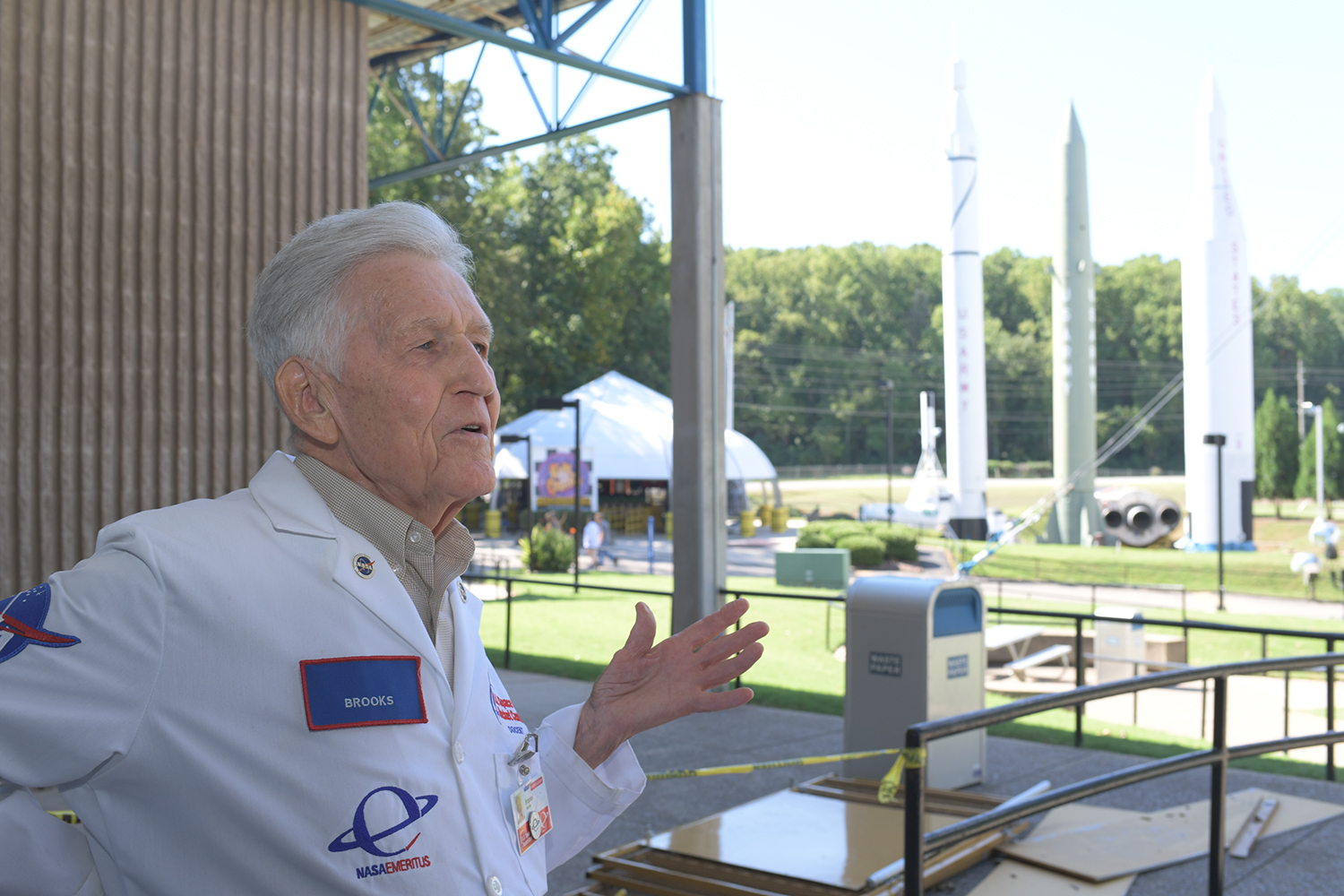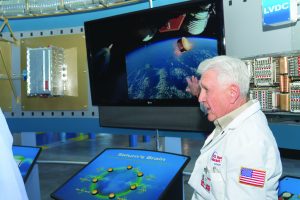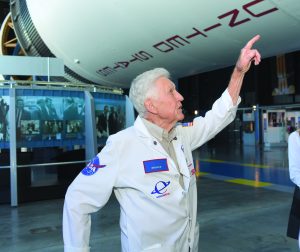 A few days a week, Brooks Moore can be found at the U.S. Space and Rocket Center in Huntsville, the largest spaceflight museum in the world. It is fitting that the renowned exhibition is located in north Alabama – where America’s space program was born, and where it continues to thrive.
A few days a week, Brooks Moore can be found at the U.S. Space and Rocket Center in Huntsville, the largest spaceflight museum in the world. It is fitting that the renowned exhibition is located in north Alabama – where America’s space program was born, and where it continues to thrive.
Nobody knows Huntsville’s history of spaceflight better than Moore, who today gives tours of the museum’s exhibits including the Saturn V Moon Rocket and America’s first satellite, Explorer I. But they are more than space artifacts to Moore. They are highlights of his career.
An Alabama native, Moore earned his bachelor’s degree in electrical engineering from Auburn, or API as it was then known, in 1948, as well as a master’s degree from Georgia Tech in 1949. He has called Huntsville home for more than six decades after joining space pioneer Wernher von Braun’s guided missile development team.
“I had an interest early on in aircraft,” Moore said. “Of course, there weren’t any missiles or rockets back then. I did read the comic book ‘Buck Rogers in the 25th Century.’ It was rocketry – it was actually showing these rockets flying around in space. I thought that was nothing but far-out thinking that would never happen in my lifetime.”
Moore was developing underwater mine and torpedo defense systems at the Naval Research Center in Panama City, Florida, when he made the decision to move to Huntsville in 1952. He was one of the first young American engineers hired to work with von Braun and his key specialists from Germany who were brought to the area after World War II and tasked to build a precision guided missile for the Army.
“Huntsville’s Redstone Arsenal was largely unused since the end of WWII and all civilians had been moved off the land much earlier,” Moore said. “It was an ideal place for missile development – lots of space, 50,000 acres. The Army moved the German team here and decided they needed to build it up with younger engineers. At that time, I was 25 years old. I was not fresh out of college like the typical young hires. I had three years of experience and a master’s degree, so I had a little jump ahead of the others. On my very first work assignment in Huntsville, however, I worked with several of the German team members and two young Auburn Engineering graduates.”
The renowned von Braun team spent the decade of the ’50s working for the Army, and had grown into a fairly large operation, with Moore serving as chief of the team’s control section. The unit initially built the 200-mile-range Redstone, the Army’s first surface-to-surface ballistic missile. It proved to be extremely accurate and reliable, and was subsequently deployed to West Germany. After the Redstone success of the early ’50s came the next “big boost in activity,” as Moore said. In early 1956, the Army assigned the team the task of building an intercontinental ballistic missile on an emergency basis.
“This was the beginning of the Cold War and U.S. intelligence learned that the Russians had an intercontinental ballistic missile, with the sudden realization that we were far behind them in the development of long-range missiles,” Moore said. “We called that a ‘crash effort.’ We were assigned to develop a 1,500-mile-range precision-guided intercontinental ballistic missile as rapidly as possible.”
The missile development team’s staffing was quickly increased and a four-star general was sent to Redstone Arsenal to head the project, reporting directly to the Secretary of Defense to “bypass all of the red tape within the Army.” With Moore directing the design of the guidance and control systems, the team developed the missile, named Jupiter, in an unprecedented 18 months. The Jupiter missile systems were rapidly matured to operational status and were deployed to Italy and Turkey.
 “While we were still with the Army we got the assignment to put up the first American satellite, Explorer I, in response to the Russians having launched Sputnik in October 1957,” Moore said. “We didn’t have a single-stage rocket with sufficient power to put anything into orbit around the Earth. However, we did have our little reliable Redstone. Earlier we had built, and successfully tested, an experimental vehicle with small, solid propelled upper stages on top of a Redstone. Our analyses indicated that with this combination we could lift a small payload to Earth orbit altitude and accelerate it to orbital velocity. Three months after we received authorization to proceed, the team launched Explorer I in January 1958. It was a resounding success – not only did it orbit the Earth once, but it continued in orbit for 13 years and 58,000 revolutions.”
“While we were still with the Army we got the assignment to put up the first American satellite, Explorer I, in response to the Russians having launched Sputnik in October 1957,” Moore said. “We didn’t have a single-stage rocket with sufficient power to put anything into orbit around the Earth. However, we did have our little reliable Redstone. Earlier we had built, and successfully tested, an experimental vehicle with small, solid propelled upper stages on top of a Redstone. Our analyses indicated that with this combination we could lift a small payload to Earth orbit altitude and accelerate it to orbital velocity. Three months after we received authorization to proceed, the team launched Explorer I in January 1958. It was a resounding success – not only did it orbit the Earth once, but it continued in orbit for 13 years and 58,000 revolutions.”
In the 1950s, the desire to develop rockets for military and space application created severe internal competition among the Army, Air Force and Navy, with each wanting to build rockets for their own purposes. President Dwight Eisenhower decided in 1958 to eliminate the space exploration rivalry by establishing a civilian agency to focus on space flight for the benefit of humanity in general, and NASA was born. The von Braun team was selected to become a part of NASA and Huntsville’s Marshall Space Flight Center was created with the assignment to develop all future U.S. spacelaunch vehicles.
“Because of the reputation we had built up here with the old reliable Redstone and the fast-track Jupiter, as well as putting up the nation’s first satellite, there is no doubt in my mind those are the reasons President Eisenhower selected Huntsville, Alabama, to be the home of Marshall,” Moore said.
The whole von Braun rocket team, which consisted of 2,000 people at the time, was reassigned to MSFC. Within the new organizational arrangement, Moore was assigned as director of the Guidance and Control Division. Under the new structure, the Army, Navy and Air Force were allowed to continue missile development for their own specific military applications, which the Army chose to continue to do at Redstone Arsenal in Huntsville.
“We already had the assignment to work on a heavy-lift launch vehicle while we were with the Army, so we continued that development and it evolved into being a vital test vehicle, designated the Saturn IB, for the Saturn V Lunar Landing Program. The first stage of the Saturn IB was really just a combination of a Jupiter and eight Redstones,” he said.
“Again, this goes back to the old ‘Buck Rogers’ comics – some of those rockets used a cluster of small engines at the base of the rocket instead of one large engine, and what we ended up doing was essentially that, we took eight Redstones and wrapped them around a Jupiter. We approached a lot of challenges in that manner, using the hardware we had available,” he added.
It had only been a year since NASA’s establishment when President John F. Kennedy made his ambitious pronouncement to send an American to the moon before the end of the decade.
“It was an all-out thing,” Moore said. “Because of the complexity of the Saturn V Lunar Launch Vehicle, it took several years – almost nine years since it was already May 1961 when he said we’d do it in this decade – so we used our little test vehicle, the Jupiter with the Redstones wrapped around it, and we developed an upper-stage single engine which became the third stage of the Saturn V. We used it on top of the ‘cluster,’ as we called it. Some of our critics laughed at us, calling it ‘Cluster’s last stand,’ he said.
“But the Saturn IB proved to be an invaluable test vehicle since we could launch lunar landing hardware and three-man crews into Earth orbit for developmental hardware and operational procedure testing while developing the much larger and more complex three-propelled-stage Saturn V,” he added.
“Developing the Saturn V was based on a step-by-step learning process dating back to the 1950s. The reliable Redstone was based on what the Germans had learned from their V2 development. We then used a lot of the same techniques and technology to develop the much larger and more powerful Jupiter. The progression continued through the Saturn IB and ultimately into the Saturn V development. In my area of specialty, the guidance and control systems, there is an evident trail of continuity of design techniques and technology from the Redstone through to Saturn V,” he added.
Throughout the ’60s, the MSFC team worked to fulfill Kennedy’s goal to send Americans to the moon. The original MSFC engineering organization, consisting of nine key technical discipline laboratories, remained intact throughout the Saturn IB/V Lunar Landing Program. Each laboratory was directed by a senior German engineer or scientist from the original von Braun team, which contributed to the continuity of the design philosophy. The Astrionics Laboratory, with the responsibility for all guidance, control, computers and electrical/electronic systems, was one of those nine laboratories. In 1969, Moore was selected to become the director of the Astrionics Laboratory, making him one of only two American engineers to become a MSFC laboratory director during the Lunar Landing Program.
Twelve Saturn V’s were launched during the Lunar Landing Program. Since the system was completely automated, flight tests could be conducted unmanned. The first two launches were unmanned flights into Earth orbit, thereby testing the systems without endangering a crew. Both flights were successful, so the decision was made to put a crew on the third launch scheduled for December 1968.
“Most people think astronauts guided us into space,” Moore said. “They did not. We used our same techniques that we used with military missiles – we used computers and electronic systems to drive the control surfaces, or gimbal the engines, to keep the vehicle flying on the desired course. We could preprogram the vehicle to hit a target. When we got into the lunar launches we had to go precisely to a certain spot in Earth orbit and direct the spacecraft toward the moon, then increase the velocity to escape Earth orbit. We did all of that automated.”
This next step called for launching Apollo 8 with Cmdr. Frank Borman and his crewmates, Jim Lovell and Bill Anders, with the intent to fly around the moon, but not land.
“It was just as exciting and important as the first landing on the moon to send the first astronauts around the moon. Of course there were some very anxious moments on that Christmas Eve 1968 when the crew was not in communication while on the back side of the moon – we didn’t know whether they were going to come out or not. When they came out around the moon, it was on live TV and you could see for the first time the picture of the whole globe. We could see the round shape of the Earth, the oceans and the lands. As we saw this view for the first time, the astronauts were reading from the Book of Genesis: ‘In the beginning, God created the Heavens and the Earth . . .’ This was such a dramatic moment. It was just as much of a highlight in my memory as the landing on the moon six months later.”
The next step in preparation for a moon landing was to send another crew around the moon, but this time they would dip down within eight miles of the lunar surface before going back into lunar orbit and then back to Earth, all executed successfully.
All of the NASA team’s meticulous step-by-step groundwork paid off on July 16, 1969, when the Saturn V rocket launched from Kennedy Space Center. Moore was inside the control center, while his family sat outside in the stands.
 “It’s amazing that we had very little difficulties on that particular flight. On some flights there were anomalies that we overcame, but on this one everything just went as smoothly as possible,” Moore said. “It was justifiably cause for a big celebration. However, there had been many celebrations along the way.”
“It’s amazing that we had very little difficulties on that particular flight. On some flights there were anomalies that we overcame, but on this one everything just went as smoothly as possible,” Moore said. “It was justifiably cause for a big celebration. However, there had been many celebrations along the way.”
While the astronauts were on their way to the moon, Moore came back to Huntsville. The Mission Control Center at Johnson Space Center in Houston was now in control of the operation.
“It was now a waiting game,” Moore said. “People ask if I went to any landing parties, but I was too uptight. I stayed home with my family and watched on TV as they landed, took that ‘one small step for man, one giant leap for mankind,’ explored the moon, returned to orbit and headed back to Earth. I celebrated when the three parachutes opened as they arrived safely back home.”
The NASA team would go on to put 12 more men on the moon and build the country’s first space station, Skylab. What used to be fiction from his childhood comic book eventually became Moore’s reality.